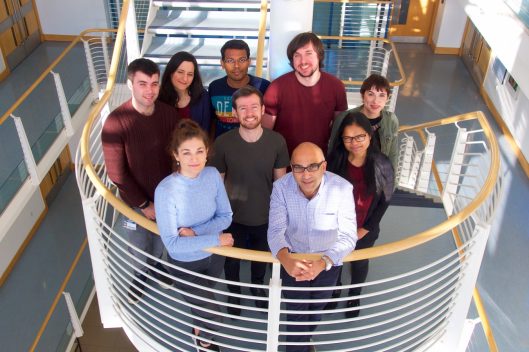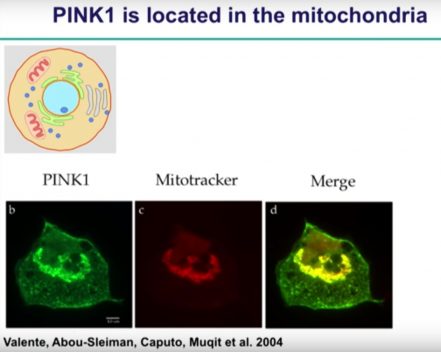We asked leading neurologist and Open Biology author Professor Miratul Muqit about his research and how genetic and biochemical discoveries are transforming our understanding of the biological basis of Parkinson’s.

Parkinson’s disease is a progressive neurological disease affecting movement and coordination due to the specific loss of dopaminergic neurons in the brain. Each year, the international community comes together on World Parkinson’s Day (11 April), to raise awareness of the illness. We asked leading neurologist and Open Biology author Professor Miratul Muqit at the University of Dundee about his research and how genetic and biochemical discoveries are transforming our understanding of the biological basis of Parkinson’s.

In 2018, Professor Muqit was awarded the Francis Crick Medal and Lecture by the Royal Society in recognition of his research on cell signalling linked to neurodegeneration in Parkinson’s disease.
How did you get into your field of work and what inspired you to do this?
During my medical degree at the University of Edinburgh, I became fascinated with the basic understanding of diseases, particularly neurological diseases. To explore this further, I went to Harvard as an undergraduate and did a summer project for Flint Beal, who is very well known for looking at the mechanism of neurodegenerative diseases from a mitochondrial perspective. His work showed that various toxins could recapitulate symptoms in animals such as the toxin MPTP in Parkinson’s. He’s been a great mentor throughout my career and my earliest influence in learning about the basic mechanisms. He also influenced my thinking on the mitochondria being an organelle clearly at the heart of Parkinson’s.
After I qualified as a doctor, I did a PhD with Nicholas Wood, where I worked on the discovery of the PINK1 gene. Working in his lab was another big influence and the seed for my own independent track to understand more about PINK1. Discovering the PINK1 gene was influenced by earlier work in Flint Beal’s lab on mitochondria, and almost coincidentally, the gene has a mitochondrial target sequence at it’s N-terminus. Our findings demonstrated that mutations in PINK1 are sufficient to cause disease and was the first direct evidence that the mechanism is a primary defect and not a consequence of having the disease.
How do you think research in the field has progressed in the past decade?
There have been big advances in the past decade but for me, there are two major highlights. One is better mechanistic understanding of some gene functions and the second, translating the genetics and biology into two clinical trials – which could be revolutionary for the treatment of PD.
10 years ago, we were fortunate to have tremendous genetic discoveries in the field which uncovered about 20 genes that are linked to monogenic forms of Parkinson’s. There’s been significant progress on understanding the functions and regulation of these genes, and also the potential biological pathways involved. For example, if you look at other genes, such as my colleague Dario Alessi’s work on the LRRK2 gene, we have much more of an understanding of how these genes and mechanisms are involved in Parkinson’s.
Parallel to the basic research that has been going on, drug discoveries have advanced to target some of these molecules. For example, we now have major clinical trials underway for LRRK2 inhibitors and the basic biology has helped the drug industry to implement trials and to develop effective treatment.
Another gene example is Glucocerebrosidase (GBA) which is associated with Gaucher’s disease and is recessively mutated in these patients. Research has uncovered that having a single mutation is linked to an increase risk in Parkinson’s and there are several companies who have now started clinical trials looking at the activators of the GBA gene.
How do you think research in the field has progressed in the past decade?
There have been big advances in the past decade but for me, there are two major highlights. One is better mechanistic understanding of some gene functions and the second, translating the genetics and biology into two clinical trials – which could be revolutionary for the treatment of PD.
10 years ago, we were fortunate to have tremendous genetic discoveries in the field which uncovered about 20 genes that are linked to monogenic forms of Parkinson’s. There’s been significant progress on understanding the functions and regulation of these genes, and also the potential biological pathways involved. For example, if you look at other genes, such as my colleague Dario Alessi’s work on the LRRK2 gene, we have much more of an understanding of how these genes and mechanisms are involved in Parkinson’s.
Parallel to the basic research that has been going on, drug discoveries have advanced to target some of these molecules. For example, we now have major clinical trials underway for LRRK2 inhibitors and the basic biology has helped the drug industry to implement trials and to develop effective treatment.
Another gene example is Glucocerebrosidase (GBA) which is associated with Gaucher’s disease and is recessively mutated in these patients. Research has uncovered that having a single mutation is linked to an increase risk in Parkinson’s and there are several companies who have now started clinical trials looking at the activators of the GBA gene.
Tell us about the next steps in your research and your collaborations
We’re very excited to have several developments underway. One aspect of our work is trying to develop better tools to monitor PINK pathway signalling, and also help companies exploit our understanding of PINK and Parkin towards translation and potential drug development.
In terms of our biological research, although we know a lot about PINK1 function and its substrates, we are trying to learn more about how it is activated. We know that when mitochondria are damaged PINK1 kinase is activated but the mechanism is not clear, so our future work is trying to understand this better much through several approaches. Firstly, trying to understand whether PINK1 activation is dependent on post-transition modifications, and also whether it’s dependent on activating protein complexes in mitochondria. We’re also trying to better understand the PINK1 structure and we have collaborations with a number of groups to address these areas.
Also, very interestingly, we recently discovered that when PINK1 is activated, it also activates the phosphorylation of Rab GTPases (these serve as molecular switches for trafficking cell ‘cargo’) and it turns out the phosphorylation site is different to sites previously identified for other genes so we’re very interested in finding out more about this regulation.

Miratul Muqit’s Research Group at the University of Dundee © University of Dundee
What do you like to do in your spare time?
I enjoy spending time with my family and also enjoy running. I still do clinical work and seeing patients really motivates the work that we do in the lab.
Finally, are there any tips would you give to someone who would like to follow in your footsteps
I think that it’s important for young scientists to focus on a single problem and it’s vital that they then focus on why it’s important and not spread out focus on multiple areas. Also, journals play an important role in helping researchers publish in a way that is painless. Publishing in a timely manner is critical for the momentum of your work.
I also think it’s important to find mentors. I’ve benefited massively in terms of having good mentors like my colleague Dario Alessi. It’s important to have a good senior mentor that you can discuss your work with and critically evaluate it. Also working in a way that is rigorous, focused and open is key.
Open Biology is looking to publish more high-quality research articles in cellular and molecular biology. Find out how to submit your work.
